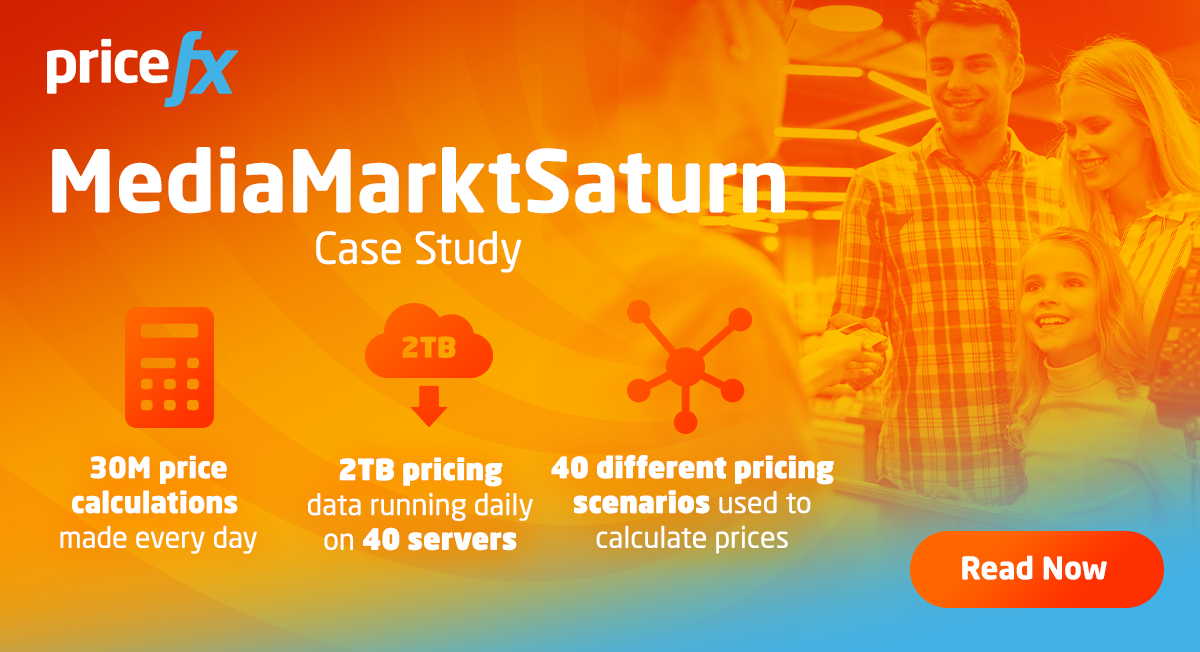Why is Price Consistency Across Sales Channels So Important?
January 22nd, 2024 | 11 min. read
Achieving pricing consistency across sales channels in today’s dynamic business landscape is no easy feat. It demands the establishment of numerous touch points and the standardization of customer experiences, irrespective of how clients engage with your brand. This could mean integrating your online and physical store presence, all with the aim of enhancing the customer journey.
However, whether in the context of B2B or B2C enterprises, some businesses struggle to keep pace with the rapid transformations underway. B2B entities may shroud their net prices behind log-in barriers, while B2C website prices are susceptible to real-time crawling by competitors, sometimes rendering them outdated within minutes of going live.
Considering that modern B2B and B2C customers are increasingly explicit about their expectations from suppliers – craving more channels, convenience, automation, self-service, and personalized experiences – this article embarks on an exploration of the significance of price consistency across sales channels.
At Pricefx, we have dedicated over a decade to helping clients monitor price shifts and market trends in real time. Through collaboration with a diverse array of omnichannel businesses, we’ve crafted technological solutions that empower today’s enterprises with the innovative tools required to engage effectively across the ever-expanding array of transaction types.
In this article, we will delve into the concept of price consistency across sales channels, weighing its merits and demerits and examine why it is so important. We will also identify those types of businesses for whom it is indispensable and offer insights on how to kickstart and execute price consistency effectively.
What Is Price Consistency and Why Is It Important?
Price consistency is the practice of maintaining uniform pricing for your company’s products and services, whether you operate in a B2B or B2C sales environment. It involves offering a seamless shopping experience to your customers across various channels, including online platforms, physical stores, social media, mobile apps, and telephone sales, irrespective of when, where, or how they choose to make a purchase.
Price consistency is vital for ensuring customer satisfaction and loyalty, as it enables your customers to enjoy a consistent experience regardless of their preferred buying method.
By implementing best-practice price consistency strategies, your business can effectively manage pricing across different channels while aligning them with your organization’s specific business objectives.
While uniform pricing across e-commerce and physical stores is ideal, it may not always be practical for all products. Certain products, for example, like intricate machinery components in the manufacturing sector, often demand tailored solutions, necessitating one-on-one consultations with expert engineers. Conversely, standardized components, such as basic fasteners, can be conveniently purchased either through in-person visits or online platforms, providing clients with flexibility and choice.
This form of standardized omnichannel pricing ensures that all sales channels within your organization align with your unique business goals. Consistent pricing minimizes the risk of alienating customers who discover price discrepancies, such as higher online prices compared to in-store prices. This is especially relevant when offering options like ‘buy online pickup in-store’ (BOPIS) or when customers use price comparison apps which are now becoming as much part of the B2B business environment as they have in B2C for a generation.
If customer loyalty and retention are central to your business strategy, maintaining price consistency is crucial. It ensures that your customers receive consistent experience and pricing, regardless of their preferred shopping method, ultimately enhancing their trust and satisfaction with your brand.
The Pros and Cons of Price Consistency for B2B and B2C Businesses

Clearly then, we can see that maintaining transparent and coherent price consistency across sales channels is crucial for both B2B and B2C enterprises. Let’s drill down a little further into the pros and cons of price consistency for the two sectors:
Pros of Price Consistency
1. Customer Trust and Loyalty
One of the primary benefits of price consistency is the establishment of trust among your customers. Whether you are a B2B supplier or a B2C retailer, when your customers see consistent pricing across all channels, they feel confident and are more likely to return for future purchases.
This trust translates into increased customer loyalty, and loyal customers tend to spend more, buy more frequently, and recommend your brand to others. Acquiring new customers can cost up to five times more than retaining existing ones. That kind of loyalty is priceless.
2. Brand Reputation
Price consistency contributes to a strong and reliable brand image. When customers know they can expect consistent prices, they associate your brand with transparency and fairness, boosting its reputation.
A positive brand reputation attracts more customers and enables you to charge premium prices, leading to increased profit margins. Customers are often willing to pay more for products or services from brands they trust, which can be a substantial profit driver for your business.
3. Reduced Customer Confusion
In a world with numerous purchase options, uniform pricing simplifies the decision-making process for customers. They do not have to compare prices across different channels, reducing confusion and making their experience smoother.
Reduced customer confusion means fewer abandoned carts or hesitations in the purchase journey, leading to higher conversion rates. This streamlined buying process results in more completed transactions and, consequently, more profits for your company.
4. Efficient Inventory Management
For both B2B and B2C businesses, maintaining consistent pricing simplifies inventory management. You can allocate resources more effectively, reducing the risk of overstock or stock outs. Effective inventory management has a direct impact on your company’s bottom line. Consistent pricing allows for more accurate demand forecasting. Inventory managers can rely on historical sales data with confidence, leading to better planning and reduced carrying costs.
By optimizing your stock levels, you can minimize holding costs, reduce waste, and prevent lost sales due to out-of-stock items. This efficiency results in increased profitability as you make the most of your resources and respond to customer demand effectively.
5. Aligning Price with Customized Experience
Providing consistent pricing aligns with the demand for personalized experiences. It allows customers to choose their preferred buying method while ensuring that the price remains consistent, meeting their expectations. A positive customer experience can be linked to increased revenue. Satisfied customers are more likely to make repeat purchases, spend more with your business, and become brand advocates.

By enhancing the customer experience through price consistency, you create a loyal customer base that can significantly boost your company’s profits over time. Additionally, these loyal customers are more forgiving of occasional price increases or less price-sensitive, which can lead to higher overall revenue.
6. Competitive Advantage
Price consistency can provide your business with a competitive advantage in the market. When customers perceive your pricing as fair and transparent, they are more likely to choose your products or services over those of competitors. This competitive edge can translate into increased market share and revenue. Additionally, it may allow you to command higher prices than competitors, leading to improved profit margins.
Another competitive advantage is that consistent pricing demonstrates a commitment to fairness and simplicity, which can be a unique selling point.
7. Streamlined Marketing Efforts
With price consistency, marketing becomes more straightforward. You can develop cohesive marketing campaigns that focus on the value and benefits of your products or services, rather than constantly having to use marketing efforts to run sales or clearance events.
This streamlined marketing approach not only saves time and resources but also leads to more effective marketing strategies that can attract and retain more customers. Improved marketing efficiency contributes to higher profitability.
Cons of Price Consistency
1. Product Variability
In some cases, such as customized B2B products or specialty items, maintaining price consistency may be challenging. Each product may require unique pricing, making uniformity difficult. This challenge can lead to increased operational costs as it requires more intricate pricing strategies and may result in lower profit margins due to the time and resources invested in tailoring pricing for specific products, potentially decreasing your company’s bottom line.
2. Competitive Pressure & Lost Sales Opportunities
In a competitive market, uniform pricing can limit your ability to respond to pricing strategies of competitors. Adapting to market fluctuations or running promotions becomes more challenging. This limitation can lead to lost sales opportunities as you may struggle to match or beat competitors’ prices, resulting in potential revenue loss and reduced profitability for your business.
In a highly competitive market, businesses often adjust prices strategically to respond to changing market conditions, competitor actions, or seasonal demand. Uniform pricing may limit the ability to offer targeted discounts or promotions, potentially putting the business at a disadvantage.
If competitors have only one channel or are using dynamic pricing strategies only in B2B or B2C, a business with uniform pricing across channels may struggle to match or compete effectively in terms of pricing.
What’s more, businesses that insist on consistent pricing may miss out on the flexibility to offer location-based discounts or targeted promotions, potentially limiting their appeal to local customers. This limitation can result in a decrease in sales revenue, as you may not effectively tap into localized demand or capitalize on opportunities to attract new customers through tailored pricing strategies.
3. Cost Considerations
Implementing price consistency across various channels may require investments in technology and infrastructure. This can be costly for businesses, particularly smaller ones. The upfront costs associated with technology upgrades and infrastructure improvements can eat into your profits, potentially decreasing your company’s bottom line in the short term.
4. Customer Expectations
In some cases, customers may expect different pricing for online and in-person purchases. Disregarding these expectations could lead to customer dissatisfaction. This dissatisfaction can result in reduced customer retention and potentially lost sales as customers seek alternatives that align with their pricing expectations. Meeting varying customer expectations may require complex pricing strategies that can be resource-intensive, affecting your profit margins.
Who is Price Consistency Right For?
If your company prioritizes delivering superior customer experiences, the implementation of pricing consistency through seamless omnichannel pricing integration can be a strategic game-changer. This approach facilitates a harmonious interaction between your customers and your business, irrespective of the sales channel they choose. The result is a significantly lowered barrier to purchase, as your pricing exhibits a level of consistency that enhances the overall buying process. This consistency not only builds trust but also instills confidence in your customers, as they encounter pricing that aligns with their expectations.
Furthermore, this type of omnichannel pricing can be tailored in the future to support your specific business objectives and product offerings. Whether you opt for uniform pricing across all channels or down the track your company may evolve into a channel-specific value-based pricing strategy as your business expands, having the price consistency as your starting point will make the transition a less painful and easier to accomplish.
What’s more if your business is a data-driven one and is adept at leveraging data and values its insights, adopting pricing consistency across channels could be a favorable choice for your business. The implementation of standardizing your omnichannel pricing can provide you with a wealth of valuable customer data that you can use to measure the effectiveness of various channels relative to one another, enabling data-driven decision-making.
Consider the following case study featuring the prominent European electronics retailer, MediaMarktSaturn, which highlights how the integration of Pricefx pricing software technology played a pivotal role in establishing price consistency, aligning their offline and online prices for maximum efficiency:
Why Price Consistency is Not for Everyone
A company, whether operating in the B2B or B2C sector, might opt for a channel-specific pricing strategy when the nature of their products or services varies significantly across sales channels. For instance, in the manufacturing sector, a company that produces industrial machinery may choose this approach. While standard machinery components are suitable for online sales with uniform pricing, highly customized, intricate machinery systems often necessitate personal consultation and tailored pricing strategies. By applying channel-specific pricing, the company can address the diverse needs of its customer base effectively. This flexibility allows them to remain competitive in the market while ensuring that customers receive appropriate pricing and service levels based on the channel they prefer, ultimately bolstering customer satisfaction and maximizing profitability.
However, while it may seem like a great idea to have wildly different prices on each channel, you need to think about how that will make the potential customer feel. Seeing a huge pricing discrepancy on one channel could lead to them moving towards your competitor rather than you.
Getting Started with Price Consistency (Or Not)
Now you know about price consistency (and whether it suits your business model or not), you ‘ll want to learn more about how to put your company’s unique omnichannel pricing strategy into motion.
Whichever way your organization wants to play it, Pricefx’s award-winning solution can help you out.
To learn more about how Pricefx can help with your chosen approach to multichannel pricing, check out this handy article below:
Or if you would like to discuss your company’s omnichannel pricing strategy needs, talk to one of our experts today to get started.
Happy Pricing!

